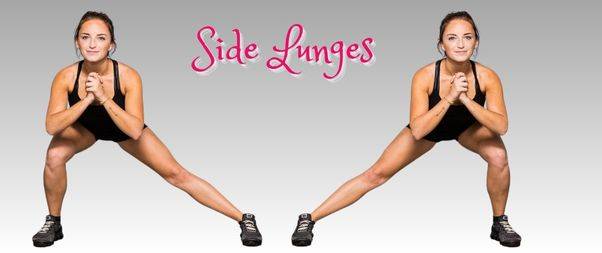If your ankles have a noticeable gap when standing upright or when your knees touch, you may have a condition known as Knock Knees.
Knock knees can lead to challenges while running and potentially give rise to pain and complications if not addressed.
The degree of this condition can vary from person to person and may progress over time if untreated.
This condition is more commonly found among those who engage in minimal physical exercise, possibly leading to tightness around the knee area.
In some cases, a crunching or clicking sound may be heard when flexing or extending the knee.
To alleviate these symptoms, there are several daily exercises specifically designed for knock knees that can help manage the condition.
To learn more about these exercises and the condition itself, continue reading the article detailed below.
What are Knock Knees

Knock knees, also known as Genu Valgum, is a common condition where the knees touch, but the ankles do not.
It represents a misalignment in your knee structure.
You can easily diagnose this by yourself. Stand up straight, keeping your knees touching each other.
If you observe a gap of about 3 inches or more between your ankles, it indicates the condition of knock knees, characterized by your knees bending inward.
Several factors may contribute to the development of knock knees, including:
- Injuries
- Arthritis
- Obesity
- Nutrient deficiencies
- Improper posture during exercise
- Incorrect walking habits
Warning Signs
Knock knees or genu valgum, is typically characterized by several symptoms. These can include:
- Knees that touch or nearly touch when standing straight with your feet and ankles together.
- An abnormal walking pattern, or gait, due to the misalignment of the knees.
- Knee pain, often due to the extra stress on the knees and sometimes other joints as well.
- In severe cases, difficulty with certain physical activities, such as running or jumping.
If the knock knees are the result of an underlying condition, additional symptoms related to that condition might be present.
If you or someone else is showing signs of knock knees and it’s causing concern, it’s a good idea to consult a healthcare provider for an evaluation.
Causes
Knock knees, typically detected during childhood, can result from disrupted bone development. It’s uncommon for this condition to manifest after the age of 4, but if it does, it’s likely due to an underlying health issue.
Causes of knock knees may include:
- Muscular weakness or weak ligaments during early development.
- Rickets, a bone disorder caused by vitamin D, calcium, or phosphate deficiency.
- Childhood obesity.
- Fractures or injuries affecting the knee joint.
- A leg bone tumor.
- Inadequate nutrition or an unbalanced diet.
- Flat feet.
Typically, physicians may recommend dietary modifications and specific exercises to correct knock knees.
If the condition is triggered by rickets or another health concern, you might need to consult a specialist.
Treatments
The treatment for knock knees (genu valgum) can vary depending on the cause and severity of the condition.
Here are some common treatment methods:
- Observation: In many children, knock knees are a part of normal development and will correct on their own over time. In these cases, the doctor may recommend regular check-ups to ensure the condition is improving as expected.
- Physical Therapy: If knock knees are causing problems with movement or pain, physical therapy may be recommended. This can include exercises to strengthen the muscles in the legs and improve balance and alignment.
- Orthotics or Braces: In some cases, special shoe inserts (orthotics) or braces might be used to help improve alignment and reduce symptoms. This is typically more common in children, as their bones are still growing and can often be realigned.
- Weight Loss: If knock knees are being caused or exacerbated by obesity, weight loss may be recommended. Losing weight can reduce pressure on the knees and improve alignment.
- Medication or Supplements: If knock knees are due to a deficiency (like Vitamin D or calcium, often seen in cases of rickets), appropriate supplementation or medication may be prescribed.
- Surgery: In severe cases, or when other treatments haven’t worked, surgery might be an option. This could include procedures to realign the bones or joints. Surgery is generally considered a last resort and is more common in adults, whose bones are not likely to correct on their own.
Remember, treatment should always be guided by a healthcare professional who can assess the individual case and recommend the best course of action.
5 Exercise To Cure Knock Knees
Exercise and physical therapy might be helpful for improving the strength and alignment of the legs.
Here are some exercises that might help:
Butterfly Flutter
This is an enjoyable and straightforward exercise to correct knock knees. Even kids can do it during playtime. It stretches the knee cap and other associated muscles, helping to improve alignment. The more you engage in fluttering, the more your knees align with your body.
To perform this exercise,
- Sit upright with your legs extended forward.
- Bend your knees and join the soles of your feet together.
- Grasp your toes with your hands and move your bent knees up and down like a butterfly flapping its wings.

Side Lunges
Generally, side lunges are utilized to tone the inner thighs and legs. However, they can also be effective as a knock knee corrective exercise, helping to align your knees and enhance your body posture.
For this workout,
- Stand upright with your feet spaced at least hip-width apart.
- Next, take a wide step to your left and bend the right knee, pushing your hips back.
- Use the strength of your legs to return to the starting position and repeat on the other side.

Sumo Squats
This knock-knee corrective exercise is a popular variation of traditional squats. During this workout, you move your knees outward, which aids in addressing knock knee syndrome. The outward push of the kneecap and other muscles encourages them to return to their proper position.
To perform this,
- Stand upright with your feet placed wider than hip-width apart and your toes pointed outward.
- Then, perform a regular squat.
- The difference with the wider foot placement is what transforms it into a sumo squat, which is beneficial for correcting knock knees.

Leg Raise
For a stretching exercise targeted at knock knees, the leg raise is a suitable choice. It can be done either sitting or lying on a yoga mat. This exercise aims to improve leg alignment and promote better body posture.
To execute a lying leg raise,
- Lie flat and place your palms under your hips.
- Engage your core muscles and lift your legs until they form a 90-degree angle with your body.
- Maintain this position for a few seconds and then slowly lower your legs back down.

Cycling
Engaging in a basic activity such as cycling can contribute to alleviating knock knees. Regularly dedicating at least 30 minutes to this exercise can help improve the alignment of your knees and promote better posture.

Points to Remember while Exercising
One with knocked knees should keep the following considerations in mind before initiating their corrective workout regimen:
- Refrain from exercises that involve running and aerobics, as the risk of injury may be increased due to knees making contact with each other.
- If exercises are causing pain, it’s important to consult a healthcare professional.
- Self-diagnosis and self-treatment of knock knees through exercise should be avoided. Since the condition could be symptomatic of an underlying health problem, it’s crucial to seek a medical diagnosis before starting any treatment.
In a Nutshell
It’s important to address knock knees promptly as they can lead to substantial joint pain, improper posture, and bone deformities in the long run.
All the exercises mentioned above can be seamlessly integrated into your home workout routine.
If you’re a beginner, consider watching instructional videos or joining a fitness class to understand the correct form and technique for these knock-knee exercises.
However, always remember to consult your doctor before embarking on any new exercise regimen.
Take Care of Yourself!
Read Also






